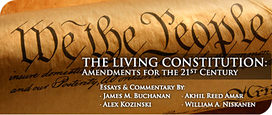Lead Essay
Nobel laureate James M. Buchanan argues that the Constitution should include amendments requiring a balanced budget, forbidding discrimination in outlays, and guaranteeing the natural liberty to exchange within and across our borders. “The ‘regulatory state’ has not worked,” Buchanan writes. “Abandonment of its constitutional legitimacy offers a starting point for constructive dialogue.”
Response Essays
Yale Law School professor Akhil Reed Amar says Buchanan’s essay offers a “veritable feast” for thought, but he turns up his nose at the menu, arguing that Buchanan’s amendments are either insufficiently supported by theory and evidence, likely to lead to distasteful consequences, or so indefinite in formulation that it is hard to say whether or not they could be made feasible.
Judge Alex Kozinski of the United States Court of Appeals for the Ninth Circuit maintains that an America that would ratify Buchanan’s proposed amendments would be an America that didn’t need them. They may not be the best ideas even if feasible, he argues. Under the nondiscrimination amendment, Kozinski predicts, “we’d have Bush v. Gore going on 365 days a year, all over the country.”
Cato Institute chairman William A. Niskanen agrees with Buchanan about ends, but disagrees about means. Niskanen offers fixes for Buchanan’s amendments and sets forth three tantalizing alternative amendments: have state legislatures — once again — elect U.S. Senators, allow the states to nullify federal law, and allow states to secede.
Related at Cato
By James M. Buchanan
James M. Buchanan, “Federalism and Individual Sovereignty,” Cato Journal, Volume 15 Number 2-3, Fall/Winter 1996.
James M. Buchanan, “Notes on the Liberal Constitution,” Cato Journal, Volume 14, Number 1, Spring/Summer 1994.
James M. Buchanan, “An American Perspective on Europe’s Constitutional Opportunity,” Cato Journal, Volume 10 Number 3, Winter 1991.
James M. Buchanan, “Reductionist Reflections on the Monetary Constitution,” Cato Journal, Volume 9 Number 2, Fall 1989.
James M. Buchanan, “Justification of the Compound Republic: The Calculus in Retrospect,” Cato Journal, Volume 7 Number 2, Fall 1987.
By others
Richard A. Epstein, “The Monopolistic Vices of Progressive Constitutionalism,” Cato Supreme Court Review, 2004-2005.
Hon. Douglas H. Ginsburg, “On Constitutionalism,” Cato Supreme Court Review, 2002-2003.
Michael C. Munger, “Constitutional Quandary: Review of The Strategic Constitution by Robert D. Cooter,” Regulation, Summer 2001.
Anthony de Jasay, “The Rule of Forces, the Force of Rules,” Cato Journal, Volume 14, Number 1, Spring/Summer 1994.
Gary M. Anderson, “The Constitution of Liberty to Tax and Spend,” Cato Journal, Volume 14, Number 2, Fall 1994.
Randall G. Holcombe, “Review of Explorations into Constitutional Economics by James M. Buchanan,” Cato Journal, Volume 9 Number 3, Winter 1990.
Peter H. Aranson, “Procedural and Substantive Constitutional Protection of Economic Liberties,” Cato Journal, Volume 7 Number 2, Fall 1987. (Issue on “Government, the Economy, and the Constitution.”)
Antonin Scalia, “Economic Affairs as Human Affairs,” Cato Journal, Volume 4 Number 3, Winter 1985.
Richard A. Epstein, “Judicial Review: Reckoning on Two Kinds of Error,” Cato Journal, Volume 4 Number 3, Winter 1985. (Issue on “Economic Liberties and the Judiciary.”)

